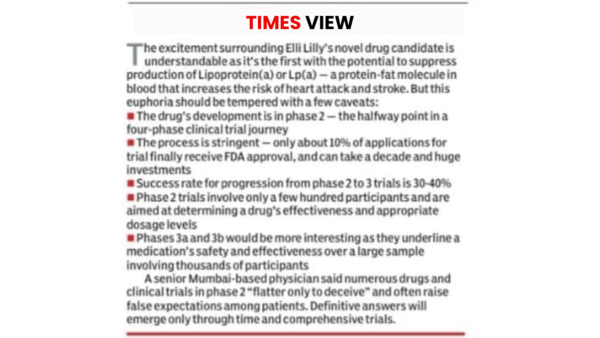A drug under the test reduces heart attacks, stroke risk

New York: One of the five – about 64 million in the US – has raised a small particle level in its blood that can greatly increase the risk of heart attack and stroke. But some know about it, and some doctors test for it, as much was not to be done. Neither diet nor exercise help. There are no drugs.
But he may change soon.
On Sunday, in the annual meeting American College of CardiologyCardiologist announced that an experimental drug made Ellie lily, LepodisiranWith the same injection, up to 94% of the particles, LP (A) can reduce the lower levels. The impact lasted for six months and had no significant side effects, simultaneously published in the ‘New England Journal of Medicine’.
At least four other companies are also testing drugs that block the production of the body of LP (A), a mixture of lipids and a protein. The first will be a study of a Novartis drug, which has been injected monthly, with expectation of results in 2026. However, these drugs are still in step 2 clinical trials and are far from making it in the market.

Time view
In addition, it has not yet been confirmed that lowering the level of LP (A) also reduces the risk of heart attack. Cardiologists are cautious because they recall a lesson learned by assuming that a risk factor can change the risk: they were once excited about drugs that raise HDL levels – “good cholesterol” was associated with low rates of heart disease – but drugs did not help.
Treats targeting LP (A) have been a long time. It was identified in 1974 as a risk factor for heart disease that is controlled by genes rather than lifestyle or environment.
People with high levels of LP (A) have a 25% increased risk of heart attack or stroke; The risk doubles at a very high level.
Cardiologists say there is no clear reason for a heart attack-high levels of high levels of common blood pressure and cholesterol LP (A). Lily trial academic leader Cleveland Clinic Dr. Steven Nisen said that the same happens for the youth with heart attacks. “If you go to the coronary care unit and see someone who is 40 years old, with an acute myocardial infarction, then you need to know the level of their LP (A),” he said. This is likely to exceed 250 nanomol per liter instead of 75.




